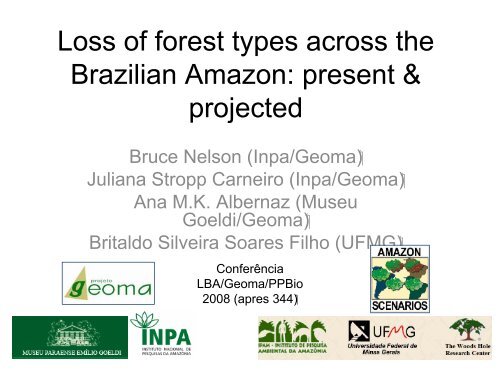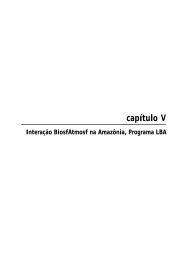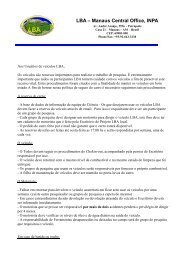Business As Usual - LBA - Inpa
Business As Usual - LBA - Inpa
Business As Usual - LBA - Inpa
Create successful ePaper yourself
Turn your PDF publications into a flip-book with our unique Google optimized e-Paper software.
Loss of forest types across the<br />
Brazilian Amazon: present &<br />
projected<br />
Bruce Nelson (<strong>Inpa</strong>/Geoma)<br />
Juliana Stropp Carneiro (<strong>Inpa</strong>/Geoma)<br />
Ana M.K. Albernaz (Museu<br />
Goeldi/Geoma)<br />
Britaldo Silveira Soares Filho (UFMG)<br />
Conferência<br />
<strong>LBA</strong>/Geoma/PPBio<br />
2008 (apres 344)
•<br />
•<br />
Two simple overlay operations<br />
Intersect present & projected<br />
deforestation surfaces with two proxies<br />
for distinct biological niches:<br />
1.<br />
2.<br />
Thematic map of forest types from Ibge/ Radam;<br />
Slices of rainfall seasonality index.<br />
Study area is the “original forest extent”<br />
in the Brazilian Legal Amazon, as<br />
defined by INPE-Prodes in 2006
•<br />
•<br />
<strong>As</strong>sumed proxies for beta<br />
diversity<br />
Different forest types have different plant<br />
communities:<br />
Different slices of rainfall gradient have<br />
distinct plant communities:<br />
Abundace,<br />
each spp<br />
Climatic gradient
Beta diversity proxies Overlays<br />
34 forest types (from IBGE, 1997)<br />
Slices of rainfall seasonality index<br />
(Walsh index derived from Worldclim)<br />
original<br />
forest extent<br />
(Prodes)<br />
Defor. as<br />
of 2006<br />
(Prodes)<br />
Defor.<br />
projected<br />
for 2036<br />
“<strong>Business</strong> <strong>As</strong> <strong>Usual</strong>”<br />
(Britaldo Soares)
Prodes product quality and ease<br />
of use are now greatly improved<br />
•<br />
•<br />
•<br />
Three years ago – many clouds and no-data<br />
areas; required temporal mosaicking of 2001-<br />
2002-2003 to reduce no-data areas; some<br />
scenes were mis-registered between years;<br />
Two years ago – good cumulative data up to<br />
2004, but still many no-data patches from<br />
clouds;<br />
This year – cloud holes up to 2006 eliminated for<br />
inferring the “original forest extent”; only ~1.5<br />
scenes missing deforestation data.
IBGE/Radam vegetation map<br />
Start with 164 vegetation<br />
types
IBGE/Radam vegetation map<br />
Consolidate into 34 types taken to be floristically distinct
IBGE/Radam vegetation map<br />
Select 20 types which INPE-Prodes agrees are, or once<br />
were, “forests”: i.e. >50% of their area is recognized as<br />
such
IBGE/Radam vegetation map<br />
Further reduce to 14 forest types whose original area was<br />
at least 10,000 km2 (due to small scale of IBGE vegetation<br />
map)
14 forest types left after<br />
•On white sand<br />
(3)<br />
•Open types (4)<br />
•Dense alluvial<br />
•Dense t.f.<br />
•Seasonal<br />
(3)<br />
•Riverine<br />
shrubland<br />
•Forested savana<br />
filtering
Fourteen forest types
Analysis confined to “original<br />
forest extent”, from Prodes
Losses quantified in black<br />
areas, detected deforestation as<br />
of 2006
Percent deforested (as of 2004)<br />
Codes Full name<br />
Deforested<br />
area, km^2 % lost as of 2004<br />
Fe1_al Seasonal forest on floodplain 4165 39<br />
Fe4_semi_bs Seasonally semi-deciduous forest 74046 39<br />
S5_flor Forested savanna (cerradão) 18645 29<br />
Fa_1_cipo_bs<br />
Open rain forest, liana dominated, lowland<br />
or submontane 75298 25<br />
Fe2_deci_bs Seasonally deciduous forest 4770 20<br />
P1_fluv_arbu Shrublands on new river deposits 2648 16<br />
Fa2_palm_bs<br />
Open rain forest, large palms dominate,<br />
lowland or submontane 92473 15<br />
Fa4_soro_bs<br />
Open forest, Phenakospermum dominated,<br />
lowland or submontane<br />
Dense rain forest on lowland or<br />
1066 15<br />
Fd2_bs<br />
Fa3_bamb_bs<br />
submontane 180379 11<br />
Open rain forest, bamboo dominated,<br />
lowland or submontane 5418 10<br />
Fd1_al Dense rain forest on floodplain 14047 4<br />
C2_flor Forest on white sand 376 1<br />
C4_tens_flom Ecotone: white sand / rain forest 142 1<br />
C1_arbo Arborescent vegetation on white sand 88 0
The situation is as obvious as<br />
the Emperor’s clothes…<br />
Hein, olhem<br />
as florestas<br />
secas…
Beta diversity proxies<br />
~40% loss of some<br />
seasonal forests by<br />
2006<br />
34 forest types (from IBGE, 1997)<br />
Slices of rainfall seasonality index<br />
(Walsh index derived from Worldclim)<br />
Original<br />
forest extent<br />
(Prodes)<br />
Defor. as<br />
of 2006<br />
(Prodes)<br />
Defor.<br />
projected<br />
for 2036<br />
“<strong>Business</strong> <strong>As</strong> <strong>Usual</strong>”<br />
(Britaldo Soares)<br />
Overlays
Walsh rainfall seasonality<br />
index<br />
Walsh index measures intensity and duration of<br />
the dry season in tropical forest, using the number<br />
of months per year in each of four rainfall classes:<br />
mm / month score<br />
< 50 -2<br />
50 - 100 -1<br />
100 - 200 1<br />
> 200 2<br />
For each site or pixel, sum 12 monthly scores.<br />
Add 0.5 for each month that falls at beginning<br />
of a dry season.<br />
Original forest<br />
extent
Losses in each climate<br />
niche as of 2006<br />
• Losses exceed 60% of some climate<br />
slices by 2006…<br />
• High pressure on dry forests, low<br />
pressure in wet area;<br />
• Remaining dry forests are also highly<br />
susceptible to ground fires and logging;<br />
many are already highly degraded<br />
Original forest<br />
extent
Walsh climate<br />
slices (2006)<br />
Outlier dry forests<br />
also attract<br />
deforestation<br />
• Only dry forest attracts<br />
deforestation (few green pixels)<br />
• Very little dry forest remains<br />
(few dark grey pixels)<br />
Remaining forest<br />
Deforested by<br />
2006
SimAmazônia (see the web site)<br />
Model period 2001 to 2036 (Britaldo Soares projections for ARPA)<br />
“<strong>Business</strong> <strong>As</strong> <strong>Usual</strong>” Infra-structure and governance levels<br />
Landscape<br />
projected for<br />
2036
Walsh rainfall seasonality<br />
index<br />
• Losses projected to approach<br />
100% in some dry forests by 2006<br />
• Eleven consecutive slices of dry<br />
forest will lose >75% of their area<br />
Original forest<br />
extent
Conservation priority: last large remnants of dry forest<br />
But what are some of<br />
these people doing?<br />
See the poster by<br />
Ana Albernaz…




